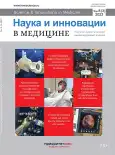A method for eliminating a chest wall defect after the sternoclavicular joint resection
- Authors: Medvedchikov-Ardiya M.A.1,2, Korymasov E.A.1, Benyan A.S.1, Rodin S.D.2
-
Affiliations:
- Samara State Medical University
- Samara City Clinical Hospital №1 n.a. N.I. Pirogov
- Issue: Vol 8, No 3 (2023)
- Pages: 220-224
- Section: Surgery
- URL: https://journal-vniispk.ru/2500-1388/article/view/249953
- DOI: https://doi.org/10.35693/2500-1388-2023-8-3-220-224
- ID: 249953
Cite item
Full Text
Abstract
Purulent arthritis of the sternoclavicular joint requires surgical treatment. The volume of the intervention depends on the degree of the joint's transformation and patient's general condition. The resulting defect of the chest wall tissues requires surgical closure at the reconstructive stage. In case of an extensive defect area with a skin deficiency, it is most advisable to use full-thickness flaps of the latissimus dorsi or pectoralis major muscles.
The article presents a clinical case of a patient operated for purulent arthritis of the sternoclavicular joint. The surgical treatment was planned in two stages. During the first stage, the use of vacuum-assisted dressings demonstrated its effectiveness. The second, reconstructive stage, included plastic surgery for the chest wall defect using a full-thickness flap of the pectoralis major on the thoracic branch of the thoracoacromial artery. The progress of the patient's surgical and general treatment was described in detail.
Full Text
##article.viewOnOriginalSite##About the authors
Mikhail A. Medvedchikov-Ardiya
Samara State Medical University; Samara City Clinical Hospital №1 n.a. N.I. Pirogov
Author for correspondence.
Email: m.a.medvedchikovardija@samsmu.ru
ORCID iD: 0000-0002-8884-1677
PhD, thoracic surgeon, deputy Chief Physician of the Thoracic Surgery Department; Associate professor of the Department of Surgery of the Institute of Postgraduate Education
Russian Federation, Samara; SamaraEvgenii A. Korymasov
Samara State Medical University
Email: e.a.korymasov@samsmu.ru
ORCID iD: 0000-0001-9732-5212
PhD, Professor, Head of the Department of Surgery of the Institute of Postgraduate Education
Russian Federation, SamaraArmen S. Benyan
Samara State Medical University
Email: a.s.benjan@samsmu.ru
ORCID iD: 0000-0003-4371-7426
PhD, Professor of the Department of Surgery of the Institute of Postgraduate Education
Russian Federation, SamaraSergei D. Rodin
Samara City Clinical Hospital №1 n.a. N.I. Pirogov
Email: doctor.ro@yandex.com
ORCID iD: 0009-0001-1594-312X
PhD, Head of the Purulent Surgery Department No. 17
Russian Federation, SamaraReferences
- Ross JJ, Shamsuddin H. Sternoclavicular septic arthritis: review of 180 cases. Medicine (Baltimore). 2004;83(3):139-148. doi: 10.1097/01.md.0000126761.83417.29
- Kuhtin O, Schmidt-Rohlfing B, Dittrich M, et al. Treatment Strategies for Septic Arthritis of the Sternoclavicular Joint. Zentralbl Chir. 2015;140(1):16-21. doi: 10.1055/s-0034-1382922
- Abu Arab W, Khadragui I, Echavé V, et al. Surgical management of sternoclavicular joint infection. Eur J Cardiothorac Surg. 2011;40(3):630-4. doi: 10.1016/j.ejcts.2010.12.037
- Othman S, Elfanagely O, Azoury SC, et al. A multi-institutional analysis of sternoclavicular joint coverage following osteomyelitis. Arch Plast Surg. 2020;47(5):460-466. doi: 10.5999/aps.2020.00717
- Ali B, Petersen TR, Shetty A, et al. Muscle flaps for sternoclavicular joint septic arthritis. J Plast Surg Hand Surg. 2021;55(3):162-166. doi: 10.1080/2000656X.2020.1856672
- Opoku-Agyeman J, Perez S, Behnam A, Matera D. Reconstruction of sternoclavicular defect with completely detached pectoralis major flap. J Surg Case Rep. 2019;2019(4):rjz122. doi: 10.1093/jscr/rjz122
- Dast S, Berna P, Qassemyar Q, Sinna R. A new option for autologous anterior chest wall reconstruction: the composite thoracodorsal artery perforator flap. Ann Thorac Surg. 2012;93(3):e67-9. doi: 10.1016/j.athoracsur.2011.10.003
- Ali B, Shetty A, Qeadan F, Demas C, Schwartz JD. Sternoclavicular Joint Infections: Improved Outcomes With Myocutaneous Flaps. Semin Thorac Cardiovasc Surg. 2020;32(2):369-376. doi: 10.1053/j.semtcvs.2019.12.007
- Medvedchikov-Ardiia MA, Korymasov EA, Benyan AS. Application of the skin-subcutaneous-fascialmuscular flap on the superior epigastric artery to close the defect of the anterior chest wall. Grekov’s Bulletin of Surgery. 2022;181(3):76-80. (In Russ.). [Медведчиков-Ардия М.А., Корымасов Е.А., Бенян А.С. Применение кожно-подкожно-фасциально-мышечного лоскута на верхней надчревной артерии для закрытия дефекта передней грудной стенки. Вестник хирургии имени И.И. Грекова. 2022;181(3):76-80]. doi: 10.24884/0042-4625-2022-181-3-76-80
- Spindler N, Kade S, Spiegl U, et al. Deep sternal wound infection – latissimus dorsi flap is a reliable option for reconstruction of the thoracic wall. BMC Surg. 2019;19(1):173. doi: 10.1186/s12893-019-0631-4
- Opoku-Agyeman J, Matera D, Simone J. Surgical configurations of the pectoralis major flap for reconstruction of sternoclavicular defects: a systematic review and new classification of described techniques. BMC Surg. 2019;19(1):136. doi: 10.1186/s12893-019-0604-7
- Malathi L, Das S, Nair JTK, Rajappan A. Chest wall reconstruction: success of a team approach-a 12-year experience from a tertiary care institution. Indian J Thorac Cardiovasc Surg. 2020;36(1):44-51. doi: 10.1007/s12055-019-00841-y
- Jo GY, Ki SH. Analysis of the Chest Wall Reconstruction Methods after Malignant Tumor Resection. Arch Plast Surg. 2023;50(1):10-16. doi: 10.1055/s-0042-1760290
Supplementary files














